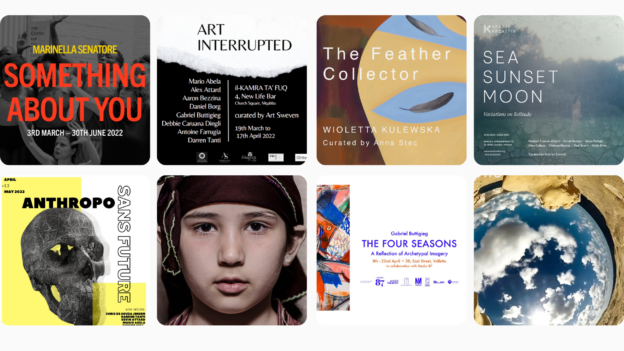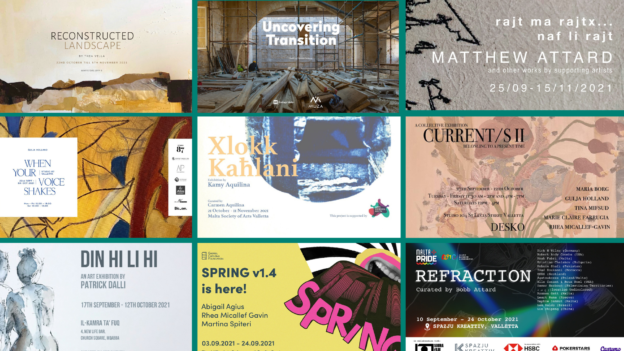Darren Tanti explores powerlessness in the face of violence in war zones

As we approach the closing of the ongoing solo exhibition Inaction is a weapon of Mass Destruction at Spazju Kreattiv and Il- Kamra ta Fuq’, Artist Darren Tanti and Curator Melanie Erixon share with us the concept and curatorial process of this delicate and immersive narrative highlighting the sense of powerlessness in the face of war zones and violence.

Inaction is a weapon of Mass Destruction at Spazju Kreattiv, Photo credits: @VE L LA
What was the main trigger and inspiration behind this body of work?

Darren Tanti
This project started around four years ago as a reaction to the dangerous threats that former US President Donald Trump and North Korea’s Supreme Leader Kim Jong-Un were posing to each other; threats that could have caused human extermination on an unprecedented scale by the simple push of one big red button (quoting President Donal Trump). At the time, the world was still grappling with various news of the unfolding disasters in Syria and other upheavals related to the 2010 Arab Spring rebellions that were still happening in North Africa and Middle East. The refugee and asylum-seekers crises was all over the news and the disasters of capsized refugee boats and mass drownings were (and sadly still are) unfolding in the Mediterranean Sea. Tensions were running extremely high. In such a scenario, I felt that I ‘had’ to do something, and even though I was fully aware that this ‘doing something’ would not really do much in the face of these tragic world affairs, I still had to do it. This something, started in the form of a number of reflections that eventually developed into small scale artworks and consequently into much larger artworks. Coincidentally, around the same period of time I attended an art/education conference in which Ai Wei Wei’s photographic interpretation of the heart-breaking Alan Kurdi’s death, was being debated and heavily criticised for being exploitative and insensitive. That particular critical argument made me think very deeply about the role of the artist in the face of war and tragedy; especially if he/she is not experiencing it directly as victim inside of the war zone. These reflections were the driver that led me to further develop that body of work and to pursue its exhibition to the public.
Even though I have never physically been into a war zone, and I have never lived the terror of violence and looming death, I can still say that I have a ‘sort’ of experience and understanding of war. The experience I am referring to, is not that of physical shelling but one that consists of a bombardment of news, images and sounds, which are delivered by mass media and social media to the people who are residing outside the warzone. For me this awareness of conflict feels like white noise; after a while one does not hear it anymore; nonetheless it would still be there, disturbing my own psychological quiet and serenity. Apart from that, I believe that feelings of powerlessness in the face of such events lead to increased anxiety and stress and as a consequence one is led to feel increasingly numb and helpless. Some people cling to futile attempts of ‘protest’ by writing opinions on Facebook and Twitter or putting a flag or a motto on their profile picture which in turn gives them a false sense of accomplishment and agency.

How would you define its relevance in the current global scenario?
Unfortunately, there are multiple reasons for which I believe the project is relevant. The tragedy of war seems to be an affliction that humans cannot get rid of, thus every attempt to fight against it must be made. In my work I am specifically targeting the perils that lie within the processes of mass media and social media by which one receives and consumes news. In a world the hyperreal seems to have become the norm, one must always be on alert. Technologies such as Deepfake and the ease by which algorithms can manipulate one’s sense of reality, make the issues discussed in the project even more salient. Hundreds of artists, curators and people in the art world have reacted to the current war in Europe. There are some who are sceptical about these reactions and think of them as pseudo-actions towards conflict resolution. Whilst I do understand the skepticism, I do not abide to the idea that these are futile attempts, historically speaking art has been used as a driving force in politics and promoter of cultural and social change. Thus, it is important that artists contribute to the fight against war in the way they can, that is through the creation of art.




Inaction is a weapon of Mass Destruction at Spazju Kreattiv, Photo credits: @VE L LA
Can you tell us a bit more about the curatorial process of this exhibition?
It has been quite an interesting challenge to curate a major solo exhibition that spans over two venues, so different in location, in size and in their nature. Spazju Kreattiv, Space C is an overwhelming space – a large segmented white cube; and il-Kamra ta’ Fuq which is a tiny space, with raw architecture, with no pristine white walls and a homey feeling, situated on top of a traditional ‘hanut tat-te’ (with all that comes with it), in the heart of Mqabba.
The first room titled ‘The Spectacular Dance of the Atom’ at Spazju Kreattiv is dedicated to the spectacularity of war and explosions. We wanted to create something of a ‘belvedere’ feeling – a spectacle, where the visitor wouldn’t be able to resist the urge to take a selfie and we were juggling ideas how to make someone stop and take selfies and still feel comfortably at home. And that’s when we had a eureka moment which dictated the whole narrative, not only of the first room but of both venues. We decided to include a sofa just in front of a spectacular artwork, which the visitor faces when arriving at the exhibition. The sofa transformed into a sitting room and of course everything became a natural progression in the next rooms, into transforming each room into a room found at home. For il-Kamra ta’ Fuq, it was decided to create a sort of clinical cocoon where the visitor will be inundated with an avalanche of information and distractions.We decided to complicate our lives as much as possible, as now we needed to transform the white cubes at Spazju Kreattiv into homely atmospheres and the cozy space in Mqabba, into a white cube.
From the living-room at Spazju Kreattiv, the narrative moves on to the study-room, titled ‘Interactive / Reactive’, where the visitor can sit at a real desk and use actual laptops to interact with two of Tanti’s works and manipulate them at their pleasure, by a custom-made software which has been developed by Justin Azzopardi and is being presented in Malta for the first time in this exhibition.The manipulation of data and news fabrication reaches its hype in the following room, the sewing room, titled, ‘The Absurdities’. A body is wrapped in fabric – a piece of textile fabric coming out of a real sewing machine. The textile is portraying an obsessive repetition of worldwide logos of the major news agencies, a design created by Tanti. The corpse is representing the passive viewer engulfed in all the news feeds. The main hyperrealist painting in this room is portraying myself as the curator, who is in theory an editor – the editor of this project.
Four monitors are looping three videos created by Tanti, which are made up of snippets from real war footage, advertisement material, notification sounds and other, which are in themselves an amplified avalanche of data and misinformation which we face every day. A number of skulls branded with logos of the most acclaimed social media platforms are displayed in a row, like soldiers under the monitors. All of this is hinting to the fact that nowadays it is so easy for anyone with a social media account to disseminate information with no accountability of what is true or fabricated. This barrage of information could easily leave one numb and empty inside. This feeling is highlighted by the series of sculptures called the ‘Empty Shells’, which is also a play on the empty shells from war weaponry.
In the last two rooms the spectacularity starts fading away and is replaced by the nightmares of reality. Both rooms are representing bedrooms, but now the bedrooms are in a state of destruction and abandonment. The first bedroom on the left, titled ‘Abstractions’, gets its name from the three major artworks covering its walls. The style of these works is a new venture for Tanti. These abstracts or semi-abstracts are imbued with emotions. The artist needed to let it all out – all the input from the research on the topic needed to burst out of him. Realistic or hyper-realistic artworks require a longer time to be executed. The emotions needed an immediate outlet and hence this quicker, stronger, darker works. The opposite bedroom, is a children’s bedroom, titled ‘The Innocent’. The tragedy and destruction continue along with a twist on the sculptures displayed here. Burnt skulls are transformed into snapchat memorabilia. Casts from toy guns are transformed into wall decorations, fitted ‘nicely’ between a cast of a pregnant woman and a sketch (meant to be a painting) portraying a real photo of dead children in a conflict zone. The sketch remained unfinished as the artist couldn’t continue working on it due to its horrible reality and the effect on his psyche.At il-Kamra ta’ Fuq, the editing was taken to a new level. As previously mentioned, we needed to create a clinical aura. A room was fabricated within the existing room. The white cube was filled with artworks which originated from the first thoughts, studies and visual responses made by the artist vis-à-vis the project. Some of the small drawings were later developed into larger works displayed at Spazju Kreattiv. This provided one aspect of the connection between the two spaces. Another tie between the two venues is by the video artworks, which are also present on each of the four walls at il-Kamra ta’ Fuq. And last but not least, both venues are also connected via numerous hashtags, which continue to emphasize the social media obsession and the absurdity of the messages in their meaning (or lack of it) and actual significance when perceived into a war context.

What should the audience expect when visiting the exhibition?
In a nutshell, this project is aimed at highlighting the numbness and desensitization that we are experiencing on a daily basis. It is a reminder to keep in mind that all the news and content especially on Social Media is not necessarily true and that nowadays anyone can fabricate content, too easily. All of this is done focusing on the theme of second-hand experience of war and conflict and to remind us all that inaction is a weapon of mass destruction.
The official launch of the exhibition catalogue will come take place on the 3rd of December at Spazju Kreattiv and on the 4th of December at Il- Kamra ta’ Fuq.

The project is in collaboration with Spazju Kreattiv and il-Kamra ta’ Fuq and is supported by Arts Council Malta through the Project Support Scheme.
Supported by ILabphoto, Briffa Wine Selections, VGB Art, BEATI PAOLI Restaurant, Culture Venture, New Life Bar – Mqabba, Art Sweven and Best Print Malta






Responses